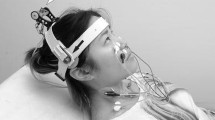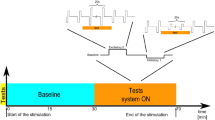Abstract
The purpose of this study was to investigate changes in neck muscle and eye movement responses during the early stages of vestibular compensation (first 3 weeks after unilateral vestibular neurectomy, UVN). Electromyographic (EMG) activity from antagonist neck extensor (splenius capitis) and flexor (longus capitis) muscles and eye movements were recorded during sinusoidal visual and/or otolith vertical linear stimulations in the 0.05–1 Hz frequency range (corresponding acceleration range 0.003–1.16 g) in the head-fixed alert cat. Preoperative EMG activity from the splenius and longus capitis muscles showed a pattern of alternate activation of the antagonist neck muscles in all the cats. After UVN, two motor strategies were observed. For three of the seven cats, the temporal activation of the individual neck muscles was the same as that recorded before UVN. For the other four cats, UVN resulted in a pattern of coactivation of the flexor and extensor neck muscles because of a phase change of the splenius capitis. In both subgroups, the response patterns of the antagonist neck muscles were consistent for each cat independently of the experimental conditions, throughout the 3 weeks of testing. Cats displaying alternate activation of antagonist neck muscles showed an enhanced gain of the visually induced neck responses, particularly in the high range of stimulus frequency, and a gain decrease in the otolith-induced neck responses at the lowest frequency (0.25 Hz) only. By contrast, for cats with neck muscle coactivation, the gain of the visually induced neck responses was basically unaffected relative to preoperative values, whereas otolith-induced neck responses were considerably decreased in the whole range of stimulation. As concerns oculomotor responses, results in the two subgroups of cats were similar. The optokinetic responses were not affected by the vestibular lesion. On the contrary, otolith-induced eye responses showed a gain reduction and a phase lead. Deficits and short-term changes after UVN of otolith- and semicircular canal-evoked collic and ocular responses are compared.
Similar content being viewed by others
Author information
Authors and Affiliations
Additional information
Received: 15 April 1997 / Accepted: 29 December 1997
Rights and permissions
About this article
Cite this article
Dit Duflo, S., Borel, L., Harlay, F. et al. Short-term changes in neck muscle and eye movement responses following unilateral vestibular neurectomy in the cat. Exp Brain Res 120, 439–449 (1998). https://doi.org/10.1007/s002210050417
Issue Date:
DOI: https://doi.org/10.1007/s002210050417




